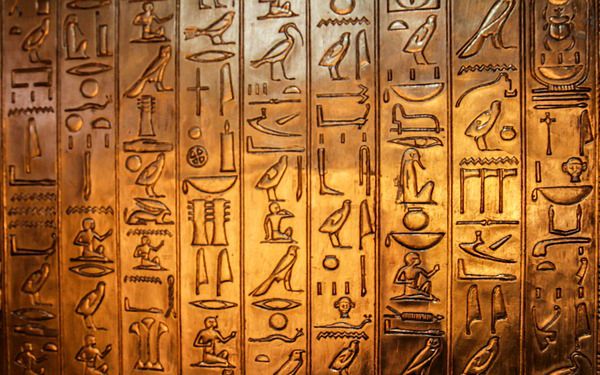Tutankhamun. The Pyramids of Giza. The Valley of the Kings.
Isn’t ancient Egyptian culture fascinating?
The culture was so advanced and so rich. It is crazy how long ago it was.
The tombs, artifacts, and hieroglyphs hold so much beauty and mystery. If you are like me, you just want to solve the big puzzle and find out what it all means.
(See Related: The secrets of puzzles)
You’ve heard of the Rosetta Stone, right? It was used to decipher Egyptian hieroglyphs. This was possible because it contained the same content in 3 different languages: hieroglyphs, demotic, and Greek. Luckily enough, the Greek text stated that the 3 messages were all the same in the different languages. An extraordinary find.
The message helped, but the deciphering of the hieroglyphs was still a great challenge. One of the major stumbling blocks was that people very much wanted to assign meaning to the symbols. In some cases, that was correct. However, a majority of the symbols represent a sound, just like our alphabet. Finally, language expert Jean François Champollion, a Frenchman, was able to crack the code.
If you visit museums, then you have likely looked at scripts from ancient cultures and wanted to be able to read them. If you were fortunate, the museum provided a translation. If not, you had to just admire the beauty and skill without understanding the content.
To change that scenario, this article will give you a quick and dirty guide to reading Egyptian hieroglyphs. It covers 10 topics at a level just right to give you a basic understanding. Hopefully, you find this helpful next time you see hieroglyphs and you can appreciate them from more than a purely aesthetic point of view.
1. History of Egyptian hieroglyphs
Hieroglyph comes from the Greek word hieroglyphikos. The combination of hierós meaning “sacred” and glýphō meaning “I engrave or carve”. So it is a noun meaning “sacred engraving”. Hieroglyph is often used interchangeably with the adjective hieroglyphic.
(If you are interested in other “glyphs”, see related: A beginner’s guide to rock art: Petroglyphs, pictographs, and geoglyphs)
First appearing around 3250 B.C., hieroglyphs were first used to write names and labels. They were carved on walls of temples and tombs, stelae (like the Rosetta Stone), coffins, and other monumental objects. As you can tell, they are highly decorative and were often painted or covered in gold. Although hieroglyphs did evolve slightly over time, the original writings would have been legible to those using the language approximately 3,000 years later. What a written history! Amazing.
2. Written forms of the Egyptian language
Egyptian was a spoken language. Unfortunately, it is no longer spoken. Along with Sumerian, it is one of the oldest recorded languages known.
There were 3 written forms of spoken Egyptian:
• Hieroglyph
The pictorial script carved on important structures and objects.
• Hieratic
Hieratic closely resembles hieroglyphs. It was essentially a form of hieroglyphs that was easy to write quickly and easily with a pen or brush. It was initially used by priests for sacred documents as well as other written letters or documents. It was most often written with a reed brush on papyrus. See an example of hieratic below.

“Edwin Smith Papyrus v2” by Jeff Dahl – Edited version of Image:EdSmPaPlateVIandVIIPrintsx.jpg. Licensed under Public Domain via Commons
• Demotic
Demotic is a more flowing and connected script. It was used in more formal and standardized government documents. It was the latest form of ancient Egyptian and eventually evolved into coptic.
3. Dates
Dates were recorded relative to the year the current king took the throne. This makes sense based on what their daily life must have been like. The biggest events that shaped their lives was probably a new king taking power.
The dates often included the year, season, month, and day.
Because of their interest and knowledge to the Sun and stars, they quite accurately represented astronomical time. Their year was 360 days with 5 days between years. They had 10 day weeks with 3 weeks to a month. They also had three seasons: inundation, emergence, and summer.
4. Writing Egyptian
I am sure you recognize that it was an art to write Egyptian. As with learning any skill, it took training by someone who knew what they were doing. It was more common to learn the handwritten form with fewer people proficient in hieroglyphs.
Scribes were taught starting when they were children. Luckily for us, the evidence of their schooling still exists. Although the language is largely phonetic, it was often taught by the word. The existing exercises show that a word was dictated and the student attempted to write it. This is known because of what the apparent mistakes were and corresponding corrections. What a great historical find! I hope they didn’t get in trouble for bad marks.
Because hieroglyphs are largely phonetic, it is theoretically possible to write the same word different ways. However, in practice, there were often standardized “spellings.”
5. Reading direction
Hieroglyphs can be written from right-to-left, left-to-right, or top-to-bottom.
The general practice was to read from right-to-left. Just as hieratic and demotic are read from right-to-left. However, because the aesthetics was so important the entire arrangement of the symbols had to be beautiful. Therefore for balance or symmetry purposes, sometimes the message was written left-to-right or top-to-bottom.
The key to knowing how to read the message is in the characters themselves. If the humans and animals are facing left, you read from the left towards their faces. Clever, huh?
6. Hieroglyphic grammar
Are you up for a game to see how observant you are? Look at the featured image for this article and see if you notice anything about how the characters are written. Go ahead, I’ll wait.
Yes, it appears the script is in columns which will need to be read from top-to-bottom. Anything else? Did you notice that the characters do not always follow each other neatly in a single line? Bonus points if you did.
Hieroglyphs are written in blocks. Each block represents a word/concept that fully utilizes the space allotted. You would read each block from top-to-bottom as well. Now I will throw a wrench into the mix, the characters/letters may be rearranged within the block to make it more aesthetically balanced. This can be confusing, but every girl knows there is a price to pay for beauty. I guess the ancient Egyptians knew this too, ha!
You may have also noticed that there is no discernible spaces between characters or punctuation. The space is consistently and cleanly filled with characters.
While the elaborate characters and aesthetic balancing sounds extremely labor intensive, and it was, there is a huge shortcut that was used. While it isn’t apparent to those ignorant in Egyptian, there are no vowels used in hieroglyphs. While this sounds a little crazy, if you know the language it is relatively easy to figure out the words. Hr s n xmpl f txt wth n vwls. See?
7. Types of characters
There are 2 categories of characters in hieroglyphs.
• Phonograms
These symbols represent a spoken sound. They may be a uniliteral, biliteral, or triliteral meaning the symbol represents the sounds of 1, 2, or 3 letter sounds. An example of a biliteral is a symbol that represents the combined sound of sh as in show.
See a chart of phonograms below.

Egyptian hieroglyph phonograms chart: Credit: talesalongtheway.com
• Ideograms
These symbols represent an entire word or concept. They may be a logogram or a determinative.
› Logograms are pictures of what the word means. An example is a picture of a mouth and it means mouth.
› Determinatives are symbols that identify how to read an associated character. They are placed after the character. Since many characters are similar and can have various forms it helps to determine the intended meaning. An example would be a vertical line following a character identifying it as a logogram. Another example is a pair of legs identifying the previous character as a motion.
8. Transliteration, transcription, and translation
Okay, so this gets a little confusing. At least, it was to me. Hieroglyphs are transliterated.
• Transliteration
The conversion of one language to another word-for-word, letter-for-letter, or sound-for-sound. The transliteration of Egyptian hieroglyphs is for the most part a sound-for-sound transliteration.
• Transcription
The conversion of spoken language into written language or from one written source to another written source. For example, names may have alternate spellings in other languages.
• Translation
The interpretation of meaning/intent of a text or spoken word and communicating that in another language.
Here is an explanation of the image below:
The first line is hieroglyphs.
The second line is the transliteration. (Note the lack of vowels.)
The third line is another transliteration in Manuel de Codage (MdC).
The fourth and fifth lines are the English translation.

Credit: www.tetisheri.co.uk
Because Egyptian is a dead language, no one knows how it truly sounded. Especially given that vowels are not included in hieroglyphs. The answer lies in Coptic, the Egyptian language of the Greco-Roman period. It preserved a large number of words from Egyptian hieroglyphs. It confirmed meaning of words and grammatical forms. It also helped greatly with missing vowels in terms of vocalization.
9. Names and titles
You may already know that royal names from the Old Kingdom and on are enclosed in an oval or cartouche. It is thought that this symbol stands for the “girdle of Isis.” This cord was worn around the waist and tied with a mystical protective knot meaning the circle of fulfilled life or the circle of the sun.
Earlier pharaoh’s names were inside a serekh, a rectangle with a falcon (Horus) on the top.
Beginning with the Old Kingdom, Kings were given 5 names.
• The Horus name. This designates the king as the god Horus, the son and successor of Osiris.
• The Two Ladies name. This name is used less often.
• The golden Horus name. This name is used less often, as well.
• The throne name (prenomen). This name is given when they become king. It is included inside the cartouche.
• The birth name (nomen). The name given at birth. It can be a name common to other members of the dynasty. It often includes the title “son of …”. It is included inside the cartouche as well.
Many names, royal and non-royal, had religious symbolism and a reference to a particular god. For example, Tutankhamen is translated as “living symbol of Amon” and Amenhotep translates as “Amon is in peace.” To be respectful of those gods regardless of where the god’s name fell in the name, it always appeared first in the placement of the symbols.
The image below shows how this works with the cartouche of Tutankhamun. The image is also nice because it displays character by character what it all means.

Tutankamun Cartouche. Credit: Thomas K. Wukitsch at http://www.mmdtkw.org/EGtkw0300-Unit3EgyptianWriting.html
10. Numbers and plurals
Being the science geek that I am, this guide wouldn’t be complete without information on their numerical system. They used a base 10 system which I think is natural for humans given that we have 10 fingers. They had a different symbol to represent different powers of ten.
To represent multiples of that power they just multiplied the symbol. Example: a coiled rope symbolizes 100, so 3 coiled ropes is equal to 300. This is also one of the ways they would represent plurals of a noun. To mean 3 fish they would literally have 3 fish symbols.
Here are the symbols for each power of ten.
1 represented by a single vertical stroke.
10 represented by a hobble for cattle.
100 represented by a coiled rope.
1,000 represented by a lotus plant.
10,000 represented by a bent finger.
100,000 represented by a tadpole or frog.
1,000,000 represented by the god Heh supporting the sky.

Credit: Encyclopaedia Britannica
Lost in translation
What do you think? Did you learn anything? If you didn’t, then you must love ancient Egyptian culture and done studying on your own. I learned a lot.
The most surprising fact I learned is the same one that prevented translation for many for so long. The symbols should be interpreted phonetically. I also enjoyed learning that they were intentional about making their script beautiful. So sophisticated and cultured, yet so long ago.
What did you find more surprising or interesting? Did you already know a lot of this information? Please let me know in the comments.
Resources
Bonewitz, Ra. Hieroglyphics. Lincolnwood, IL: Contemporary, 2001. Print.
Budge, E. A. Wallis. First Steps in Egyptian Hieroglyphics: A Book for Beginners. Mineola, NY: Dover Publications, 2003. Print.
Collier, Mark, and Bill Manley. How to Read Egyptian Hieroglyphs: A Step-by-step Guide to Teach Yourself. Berkeley: U of California, 1998. Print.
Egyptian transliteration: will it survive the digital era, or will it be replaced by Manuel de Codage? from Tetisheri: My love affair with ancient Egypt
“Hieroglyph.” Encyclopedia Britannica Online. Encyclopedia Britannica, n.d. Web. 01 Oct. 2015. <https://www.britannica.com/topic/hieroglyph/images-videos>.
Kamrin, Janice. Ancient Egyptian Hieroglyphs: A Practical Guide. New York: Harry N. Abrams, 2004. Print.
Read And Write Like An Egyptian from Tales Along The Way
What Is Transcription, Transliteration And Translation? from lipikaar.com
Wikipedia contributors. “Egyptian hieroglyphs.” Wikipedia, The Free Encyclopedia. Wikipedia, The Free Encyclopedia, 19 Sep. 2015. Web. 30 Sep. 2015.







